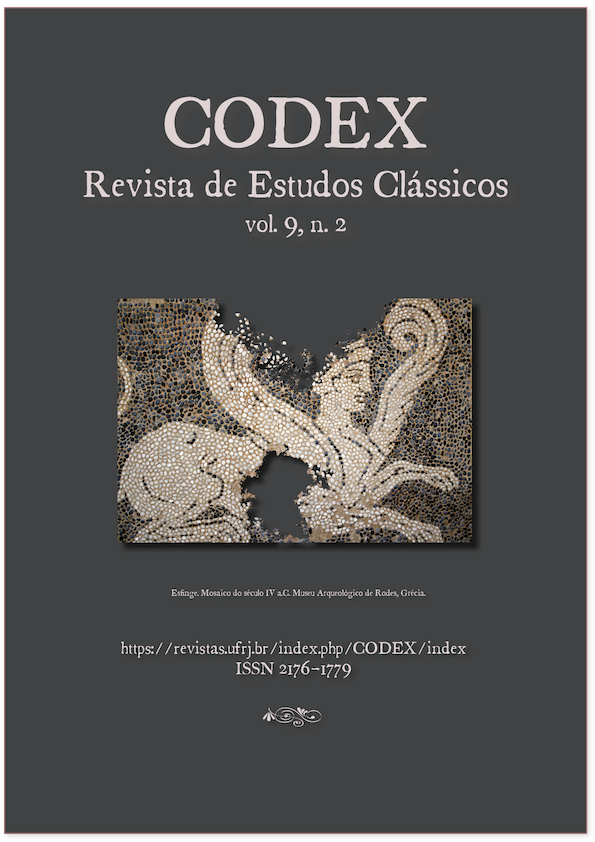From dictatorship to apotheosis: Caesar and memory in the "fora" of Rome during the end of the Republic
DOI:
https://doi.org/10.25187/codex.v9i2.44836Keywords:
Caesar, Forum Iulium, Forum Romanum, memoryAbstract
The Roman forum underwent many transformations throughout the Republican period, but it was during the crisis of the 1st century BC that this space was violently disputed between great political leaders. In the last days of the Republic the most profound and structural changes were set in motion, led by Julius Caesar still alive or sustaining his figure as a fundamental element to the new visuality of the forum in the years after the Ides of March. In his dictatorship, not only the old Forum Romanum had been altered, but a new forum, adjacent to the old one, was erected too – the Forum Iulium. Octavian, heir to the late dictator, continued the reforms initiated by his father. Thus, the landscape of the complex formed by the two fora mobilized elements of the Roman past and modified and obliterated so many others, which promoted the construction of a collective memory that had in Caesar one of its main bases: in life or posthumously, his memory became ubiquitous in the heart of Rome. In this article, we will analyze the process of construction of collective memory by the urban landscape of the forums, paying particular attention to the role attributed to the image of Julius Caesar in such memory.
Downloads
References
CADARIO, Matteo. Le statue di Cesare a Roma tra il 46 e il 44 a. C.. In: Annali della Facoltà di Lettere e Filosofia dell’Università degli Studi di Milano, Milano, vol. 59.3, p. 25-70, 2006.
CARANDINI, Andrea. La Roma di Augusto in 100 monumenti. Novara: UTET, 2014.
CARANDINI, Andrea. (Ed.). The Atlas of Ancient Rome: biography and portraits of the City. Princeton: Princeton University Press, 2017.
COARELLI, Filippo. Il foro romano: periodo repubblicano e augusteo (vol. II). Roma: Quasar, 1985.
DAVID, Jean-Michel. I luoghi della politica dalla Repubblica all’Impero. In: ANDREA, Giardina (Ed.). Storia di Roma dall’Antichità a oggi. Laterza: Editori Laterza, 2000, p. 57-83.
FARIA, Ernesto. Dicionário latino-português. Belo Horizonte: Garnier, 2021.
FILIPPI, Dunia. Region VIII: Forum Romanum Magnum. In: CARANDINI, Andrea (Ed.). The Atlas of Ancient Rome: biography and portraits of the City. Vol. 1: Text and images. Princeton: Princeton University Press, 2017, p. 143-206.
FLOWER, Harriet I. The art of forgetting: disgrace & oblivion in Roman political culture. Chapel Hill: The University of North Carolina Press, 2006, p. .
GILDENHARD, Ingo; GOTTER, Ulrich; HAVENER, Wolfgang; HODGSON, Louise (Eds.). Augustus and the destruction of History. The politics of the past in Early Imperial Rome. Cambridge: Cambridge Philological Society, 2019, p. 1-36.
KOORTBOJIAN, Michael. The divinization of Caesar and Augustus: precedents, consequences, implications. Nova York: Cambridge University Press, 2013.
LE GOFF, Jacques. História e memória. Campinas: Editora da Unicamp, 2013.
NORA, Pierre. Pierre Nora en les lieux de mémoire. Montevidéu: Trilce, 2008.
OSGOOD, Josiah. Caesar’s legacy: Civil War and the emergence of the Roman Empire. Cambridge: Cambridge University Press, 2006.
POLLINI, John. From Republic to Empire: rhetoric, religion, and power in the visual culture of Ancient Rome. Norman: University of Oklahoma Press, 2012.
POLO, Francisco Pina. I Rostra come espressione di potere della aristocrazia romana. In: URSO, Gianpaolo (Ed.). Popolo e potere nel Mondo Antico. Pisa: Edizioni ETS, 2005, p. 141-155.
STEVENSON, T. R. Parens Patriae and Livy’s Camillus. In: Ramus, Cambridge University Press, vol. 29.1, p. 27-46, 2000.
WESTALL, Richard. The Forum Iulium as representation of Imperator Caesar. Mitteilungen des deutschen archaeologischen Instituts Roemische Abteilung. Darmestadd: Verlag Philipp von Zabern, vol. 103, p. 83-118, 1996.
ZANKER, Paul. Augusto y el poder de las imágenes. Trad. de Pablo Diener Ojeda. Madrid: Alianza Editorial, 2008.
ZANKER, Paul. The irritating statues and contradictory portraits of Julius Caesar. In: GRIFFIN, Miriam (Ed.). A companion to Julius Caesar. Oxford: Wiley-Blackwell, 2009, p. 288-314.
Downloads
Published
How to Cite
Issue
Section
License
This work is licensed under a Creative Commons Attribution-NonCommercial 4.0 International License.










